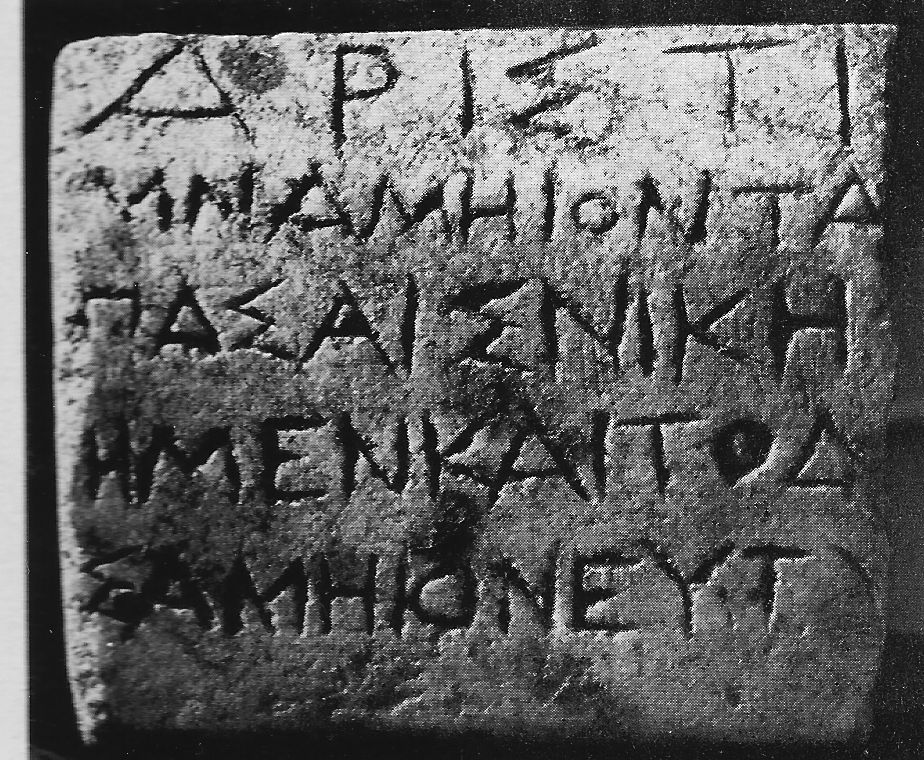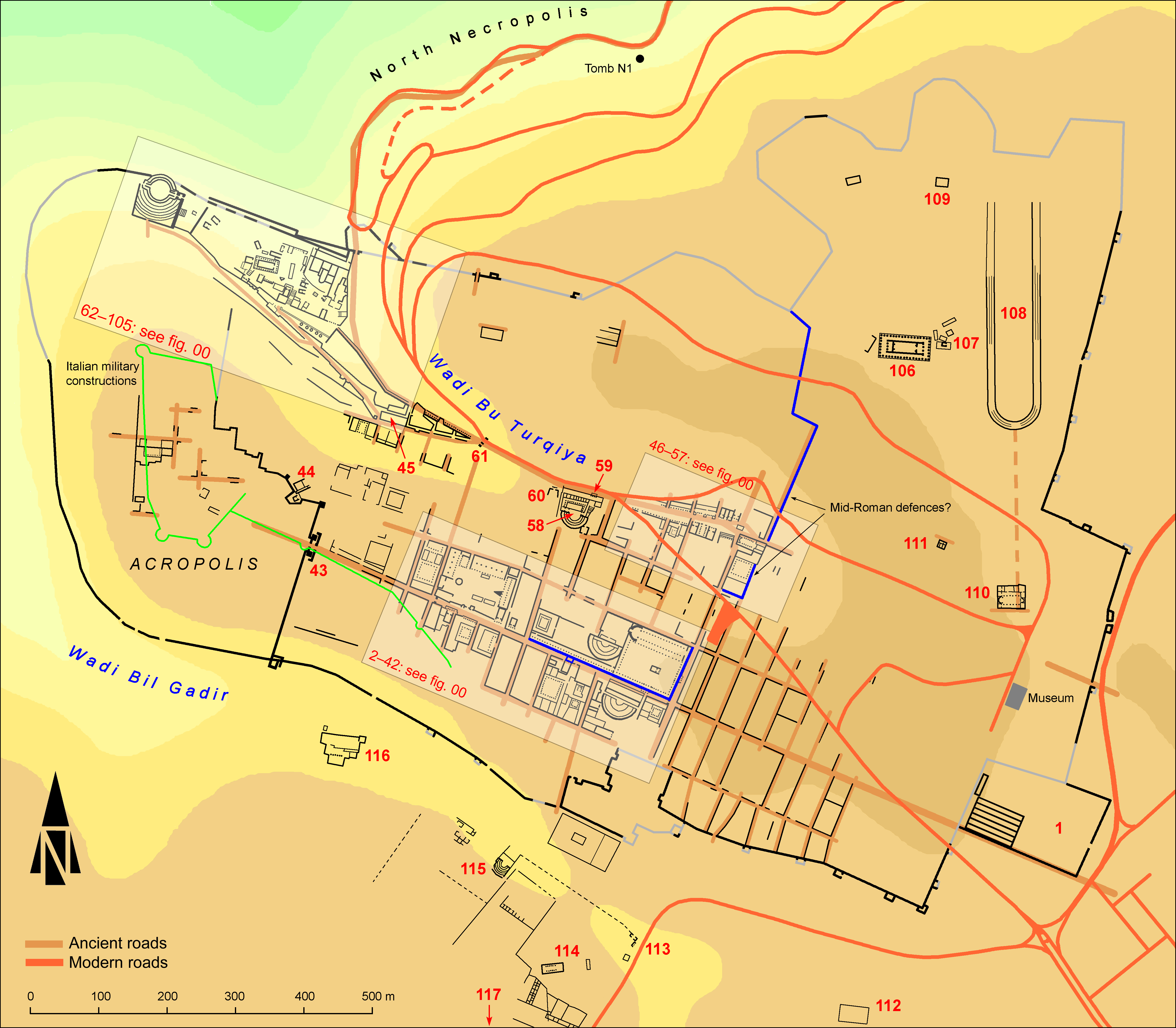EpiDoc XML:
GVCyr0032
Trismegistos ID:
738899
Source description
Support: Probably marble panel, broken off at right (w: 0.095 × h: 0.09 × d: 0.032).
Layout: Inscribed on front face in five lines.
Letters: 0.01 (ll. 2-5) and 0.017 (l. 1); alpha with low bar, slightly slanting mu, smaller omicron, much slanting sigma, widely open upsilon.
Date: Perhaps fourth century BC (lettering).
Findspot: Found by G. Oliverio before 1935 at Cyrene ➚: exact findspot unrecorded.
Place of origin: Findspot.
Last recorded location: Not seen by GVCyr team.
Text constituted from: Transcription from editor.
Bibliography
From †Oliverio's papers Pugliese Carratelli – Oliverio 1961, n. 15, whence SEG, 20.746; SECir, p. 369; Peek 1972, n. 2; CEG, n. 681; GVCyr 003 ➚.
Text
Apparatus
2: μναμῆιον Peek 1972, CEG: μναμήϊον Pugliese Carratelli – Oliverio 1961 || τα[---] Pugliese Carratelli – Oliverio 1961, CEG: τά[φωι ἀνδρὸς ἐφέστακ', ὅστις ὅτ' ἔζη] Peek 1972
3: νικη[---] Pugliese Carratelli – Oliverio 1961: νίκη [πάντας ἑαῖς ἀρεταῖσι πολίτας·] Peek 1972; νίκη [---] CEG
4: ἦμεν SEG, SECir, CEG: ἷμεν Pugliese Carratelli – Oliverio 1961; ἠμὲν Peek 1972 || τόδ[ε ---]: ΤΟΔ[---] Pugliese Carratelli – Oliverio 1961; τόδ[ε γνοὺς καὶ κοινὸν χαῖρε προσείπας] Peek 1972; τόδ[ε? ---] CEG
5: σαμῆιον Peek 1972, CEG: σαμήϊον Pugliese Carratelli – Oliverio 1961 || εὐτυ̣[χίας ---]: εὐτυ̣[---] Pugliese Carratelli – Oliverio 1961; εὐτυ[χῶν παρέρπ', ὁδοιπόρε.] Peek 1972; Eὐτύ[χ---] CEG
French translation
Aristi[---].
Mémorial de [---] victoire/ayant vaincu en toutes les [---] que ceci soit aussi [---] signe de sa réussite [---].
English translation
Aristi[---].
Memorial of [---] victory/having winned in all the [---] that this be also [---] sign of his success [---].
Italian translation
Aristi[---].
Memoriale di [---] vittoria/avendo vinto in tutte le [---] che questo sia anche [---] segno del suo successo [---].
Arabic translation
أريستى [---]. نصب تذكاري [---]للنصر أو بعد الفوز في جميع ال[---] أن هذا يكون أيضًا [---] علامة على نجاحه [---].
Commentary
For μναμῆιον and σαμῆιον, at ll. 2 and 5, instead of an epic reading with diaeresis, the reading of suffixe ῆιο as dissyllabic along with the dialect is more plausible. See Dobias-Lalou 2000, pp. 22-24. Both words are placed so as to create a meaningful echo. Those words would well appear in a funerary context and Peek's restorations clearly rely on such an interpretation. However the support of funerary verse is normally a base or a stele. A panel might better fit a honorific monument.
At line 4, Hansen's idea in CEG of a personal name indicating the person responsible for the monument is interesting although not proved. Εὔτυχος is the only name attested for the Greek period of Cyrenaica. Altogether we prefer for metrical reason the abstract noun meaning 'good luck, success'. Jointly with the idea of 'victory' (either with the name or with the verb), they are connected to the double function of the inscription, both intended to 'remember' and to 'give notice' of the deeds of Aristi[---]. The shape and dimensions might well fit the basis of one of the numerous reliefs with carriages of four horses that are now displayed in the Cyrene Museum.
Anyhow, the uncomplete personal name at line 1 was surely followed by the father's name. This shows that more than one half of each line of script is probably lost, whence a poem of four verses.
Metrical analysis: what we can say about those four lines is that they are all constituted of dactyls. We suppose that lines 3 and 5 were pentameters, but hexameters are not impossible. In σαμῆιον the diphthong of the second syllable (see above) is abbreviated in the hiatus. Nothing compels to find a iambic structure for line 5 as did Peek 1972 and differently Hansen in CEG.
CC BY-NC-SA 4.0 Deed Attribution-NonCommercial-ShareAlike 4.0 International License.
All citation, reuse or distribution of this work must contain a link back to DOI: https://doi.org/10.60760/unibo/igcyrgvcyr2 and the filename (IGCyr000000 or GVCyr000), as well as the year of consultation.

